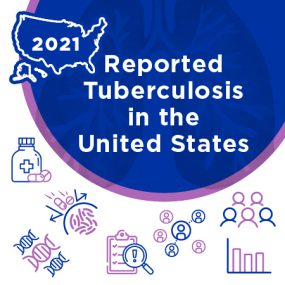Dear Colleague Letters
CDC Releases “Reported Tuberculosis in the United States, 2021”
November 29, 2022
Dear Colleagues,

Earlier this year, on March 25, 2022, CDC published provisional tuberculosis (TB) data in CDC’s Morbidity and Mortality Weekly Report. The full report, Reported Tuberculosis in the United States, 2021, is now available exclusively online.
The report describes information on TB disease reported to the CDC since 1993, with an emphasis on TB disease cases counted by the reporting jurisdiction in 2021 and the ongoing effects of the COVID-19 pandemic on TB disease surveillance.
In 2020, the annual rate of decline was substantially greater than in previous years, probably because of factors associated with the COVID-19 pandemic, including a combination of TB underdiagnosis and a true reduction in incidence. TB incidence partially rebounded in 2021, which might be explained by a lessening of the effects of the factors associated with the COVID-19 pandemic, as well as delayed detection of cases with symptom onset during 2020 that were not diagnosed until 2021 because of delayed healthcare access or missed diagnoses. Despite the rebound, TB incidence in 2021 remained 12.4% lower compared with 2019, which might be explained by longer lasting effects of the COVID-19 pandemic. Timely diagnoses of TB disease save lives and prevent spread in our communities.
Key Data Points:
- The reported number of TB cases in the United States increased from 7,171 TB cases in 2020 to 7,882 TB cases in 2021, a 9.9% increase.
- The national TB incidence rate increased from 2.2 cases per 100,000 persons in 2020 to 2.4 cases per 100,000 persons in 2021. Nine states and the District of Columbia reported TB disease incidence rates higher than the national TB disease incidence rate.
- As in past years, cases of TB disease were not evenly distributed across the United States. Four states account for almost half (49.9%) of all reported U.S. TB cases: California, Texas, New York (including New York City), and Florida.
- In 2021, people from racial and ethnic minority groups and non-U.S.–born persons continued to be disproportionately affected by TB disease in the United States, highlighting the persistent health disparities and inequities among people with TB disease.
As the effects of the COVID-19 pandemic shift over time, we must rededicate our efforts and resources to achieve TB elimination in the United States. Ending TB will require a dual approach of maintaining and strengthening current TB control priorities, while increasing efforts to identify and treat latent TB infection, especially in populations at increased risk for TB disease.
To support TB education and outreach to clinicians, health care agencies, and community organizations, CDC has created the following materials to highlight findings from the 2021 surveillance report:
We gratefully acknowledge the contributions of all state and local health departments throughout the United States whose staff collected and reported the data used in the 2021 surveillance report.
Thank you for your work and commitment to eliminate TB in the United States.
Sincerely,
Philip LoBue, MD, FACP, FCCP
Director
Division of Tuberculosis Elimination
National Center for HIV, Viral Hepatitis, STD, and TB Prevention